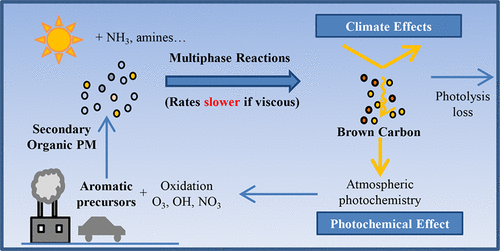当前位置:
X-MOL 学术
›
ACS Cent. Sci.
›
论文详情
Our official English website, www.x-mol.net, welcomes your
feedback! (Note: you will need to create a separate account there.)
Highly Viscous States Affect the Browning of Atmospheric Organic Particulate Matter.
ACS Central Science ( IF 12.7 ) Pub Date : 2018-01-17 , DOI: 10.1021/acscentsci.7b00452 Pengfei Liu 1 , Yong Jie Li 1, 2 , Yan Wang 1, 3 , Adam P Bateman 1 , Yue Zhang 1, 4 , Zhaoheng Gong 1 , Allan K Bertram 5 , Scot T Martin 1, 1
ACS Central Science ( IF 12.7 ) Pub Date : 2018-01-17 , DOI: 10.1021/acscentsci.7b00452 Pengfei Liu 1 , Yong Jie Li 1, 2 , Yan Wang 1, 3 , Adam P Bateman 1 , Yue Zhang 1, 4 , Zhaoheng Gong 1 , Allan K Bertram 5 , Scot T Martin 1, 1
Affiliation

|
Initially transparent organic particulate matter (PM) can become shades of light-absorbing brown via atmospheric particle-phase chemical reactions. The production of nitrogen-containing compounds is one important pathway for browning. Semisolid or solid physical states of organic PM might, however, have sufficiently slow diffusion of reactant molecules to inhibit browning reactions. Herein, organic PM of secondary organic material (SOM) derived from toluene, a common SOM precursor in anthropogenically affected environments, was exposed to ammonia at different values of relative humidity (RH). The production of light-absorbing organonitrogen imines from ammonia exposure, detected by mass spectrometry and ultraviolet-visible spectrophotometry, was kinetically inhibited for RH < 20% for exposure times of 6 min to 24 h. By comparison, from 20% to 60% RH organonitrogen production took place, implying ammonia uptake and reaction. Correspondingly, the absorption index k across 280 to 320 nm increased from 0.012 to 0.02, indicative of PM browning. The k value across 380 to 420 nm increased from 0.001 to 0.004. The observed RH-dependent behavior of ammonia uptake and browning was well captured by a model that considered the diffusivities of both the large organic molecules that made up the PM and the small reactant molecules taken up from the gas phase into the PM. Within the model, large-molecule diffusivity was calculated based on observed SOM viscosity and evaporation. Small-molecule diffusivity was represented by the water diffusivity measured by a quartz-crystal microbalance. The model showed that the browning reaction rates at RH < 60% could be controlled by the low diffusivity of the large organic molecules from the interior region of the particle to the reactive surface region. The results of this study have implications for accurate modeling of atmospheric brown carbon production and associated influences on energy balance.
中文翻译:

高粘度状态影响大气有机颗粒物质的褐变。
最初,透明的有机颗粒物(PM)会通过大气颗粒相化学反应变成浅吸收棕色的阴影。含氮化合物的产生是褐变的重要途径之一。但是,有机PM的半固态或固态物理状态可能会使反应物分子充分缓慢地扩散,从而抑制褐变反应。在本文中,源自甲苯的次生有机材料(SOM)的有机PM(在人为影响的环境中是常见的SOM前体)在不同的相对湿度(RH)值下暴露于氨中。质谱法和紫外可见分光光度法检测到的氨暴露产生的光吸收性有机氮亚胺在RH <20%的动力学作用下(6分钟至24小时)被动力学抑制。通过比较,从20%到60%RH的有机氮产生,这意味着氨的吸收和反应。相应地,在280至320 nm范围内的吸收指数k从0.012增加到0.02,表明PM褐变。380至420 nm范围内的k值从0.001增加至0.004。通过考虑了组成PM的大有机分子和从气相进入PM的小反应物分子的扩散性模型,可以很好地捕获观察到的与RH有关的氨吸收和褐变行为。在模型中,根据观察到的SOM粘度和蒸发量计算了大分子的扩散率。小分子扩散率由通过石英晶体微量天平测量的水扩散率表示。该模型表明在RH <下的褐变反应速率 大有机分子从粒子内部区域到反应性表面区域的低扩散率可以控制60%。这项研究的结果对大气中褐碳的产生以及对能量平衡的相关影响的精确建模具有重要意义。
更新日期:2018-01-17
中文翻译:

高粘度状态影响大气有机颗粒物质的褐变。
最初,透明的有机颗粒物(PM)会通过大气颗粒相化学反应变成浅吸收棕色的阴影。含氮化合物的产生是褐变的重要途径之一。但是,有机PM的半固态或固态物理状态可能会使反应物分子充分缓慢地扩散,从而抑制褐变反应。在本文中,源自甲苯的次生有机材料(SOM)的有机PM(在人为影响的环境中是常见的SOM前体)在不同的相对湿度(RH)值下暴露于氨中。质谱法和紫外可见分光光度法检测到的氨暴露产生的光吸收性有机氮亚胺在RH <20%的动力学作用下(6分钟至24小时)被动力学抑制。通过比较,从20%到60%RH的有机氮产生,这意味着氨的吸收和反应。相应地,在280至320 nm范围内的吸收指数k从0.012增加到0.02,表明PM褐变。380至420 nm范围内的k值从0.001增加至0.004。通过考虑了组成PM的大有机分子和从气相进入PM的小反应物分子的扩散性模型,可以很好地捕获观察到的与RH有关的氨吸收和褐变行为。在模型中,根据观察到的SOM粘度和蒸发量计算了大分子的扩散率。小分子扩散率由通过石英晶体微量天平测量的水扩散率表示。该模型表明在RH <下的褐变反应速率 大有机分子从粒子内部区域到反应性表面区域的低扩散率可以控制60%。这项研究的结果对大气中褐碳的产生以及对能量平衡的相关影响的精确建模具有重要意义。











































 京公网安备 11010802027423号
京公网安备 11010802027423号